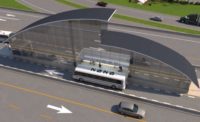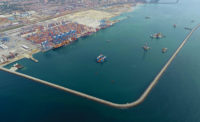A “city” is how South Carolina Ports Authority project manager Butch Weber characterizes the new Hugh K. Leatherman Terminal in North Charleston. And it’s an apt description. The program to redevelop a shuttered Navy base and dredge spoil disposal basin into a 286-acre international shipping complex involves creating buildings, storage and rail transfer facilities, utilities, street infrastructure and a wharf equipped with massive ship-to-shore cranes capable of servicing the next generation of oceangoing container vessels.
With a projected annual capacity of 2.4 million twenty-foot equivalent units (TEUs) at full build-out, the Leatherman Terminal will double the Port of Charleston’s existing container handling capabilities, enhancing its ability to compete with other East Coast maritime facilities for international shipping business facilitated by the expanded Panama Canal.
“The port is a huge economic engine for South Carolina,” Weber says, noting Charleston’s current ranking among the nation’s 10 busiest ports. “Falling behind would not be good for us.”
The program’s $1-billion, 135-acre first phase, scheduled for completion in March 2021, will be a major milestone in a years-long effort to make the site both accessible for large vessels and suitable for new construction. That included a nearly complete $558 million Corps of Engineers-funded project to deepen Charleston harbor to 52 ft, making it the deepest on the East Coast.
Sitework for the first phase officially began in 2007 with the demolition of dozens of abandoned Navy-era industrial buildings and existing utility infrastructure and the removal of the structures’ support piles where possible. Given the highly compressible nature of Charleston-area soils, more than 33.5 million linear ft of wick drains were installed 45 to 60 ft deep across the site, then covered and graded with more than 4.1 million tons of imported stone and an equal amount of sand to achieve a century’s worth of settlement over approximately 30 months.
“On average, we’ve seen 6 feet of settlement, with some areas as much as 12 feet,” says Walter Lagarenne, SCPA’s director of engineering and permitting. “Now that we’re in the site development stage, we’ve eliminated most of the settlement risk, but there’s always concern that there may be more.”
“We’ve been able to incorporate a lot of innovative value engineering from the contractors.”
– Butch Weber, Project Manager, South Carolina Ports Authority
By 2017, the site was ready for the initial phase of infrastructure and facilities construction to begin, with HDR providing program management, construction site supervision, quality assurance and detailed design review. Rather than bid the project as a single contract, Weber explains that breaking tasks into separate design-bid-build packages offered the most effective avenue to managing the programs’ many complexities while also maximizing value to SCPA.
“We’ve been able to incorporate a lot of innovative value engineering from the contractors, making somewhat of a design-build approach,” Weber says. HDR estimates that value engineering innovations have saved $39 million from the original Phase 1 estimates.
One example is the facility’s initial 1,400-ft-long wharf designed to accommodate 19,000 TEU neo-Panamax vessels. A proposal by the joint venture of Cape-Romain Contractors/McLean Contracting to utilize precast elements helped reduce the wharf’s complexity while also speeding construction. Construction of the wharf required the use of two 150-ton barge-mounted whirley cranes—provided by McLean Contracting via the Cape-Romain/McLean Joint Venture—for pile driving and setting precast pile caps and planks, says HDR.
To support the five 1,700-metric-ton cranes in the muddy, lime-rich strata of the Cooper Marl, which is particularly vulnerable to liquefaction in the seismically active area, the wharf’s robust foundation includes 581 24- and 30-in.-dia prestressed concrete piles driven as deep as 145 ft.
Other contractor-developed VE suggestions also produced savings in constructing the initial section of what will be a 164.4-acre container yard, including using conventional asphalt paving and optimizing the number of light poles. And thanks to upgrades to the city’s water system completed following the project’s original design, SCPA was able to delete a planned $1-million dedicated pump station from the budget.
Additional concurrent contracts for the Leatherman Terminal’s sitework, facilities and infrastructure have resulted in multiple teams working literally side by side on separate, yet interrelated elements within the relatively small Phase 1 footprint. That’s created what HDR construction director Andy Thiess calls “a real coordination puzzle,” particularly for site development contractor Banks Construction Co.
“Five contracts are connected to ours, which makes us the hub of activity,” says Greg Cook, senior project manager at Banks. For example, 13 buildings and canopies totaling 123,000 sq ft being constructed by Samet Corp. are being synchronized with Banks’ site activity and nine underground utility scopes of work.
“That means coordinating more than 300 people across our 22 subs every day,” Cook says.
Yet with separate but competing priorities, Cook adds, “we have worked hard to coordinate activities on site and help each other work in priority locations.”
Thiess likewise praises the high degree of collaboration. “If one contractor needs a pile of dirt moved, they have no problem asking another one to do it,” he says. “It’s really worked out well.”
The Leatherman Terminal’s office buildings, security booths and other support facilities are constructed with conventional steel frames with block, brick and metal panel exteriors, while the canopies are pre-engineered metal framing. All structure foundations are driven piles with grade beams. All structures are designed to withstand both earthquake and high wind loads.
Cape-Romain is handling the program’s other major transportation elements, which include a realigned roadway to preserve access to a nearby publicly owned marina and extending the new South Carolina DOT-built Port Access Road onto SCPA property. That work requires approximately 200 ft of new bridge sections to bring the elevated highway to ground level to connect with the terminal’s new road network.
The Leatherman Terminal’s next coordination hurdles will come this summer, with wharf construction to be completed in time for the scheduled arrival of Chinese-manufactured components for the large cranes. Contractors also need to wrap up work in areas adjacent to the wharf to provide space for assembling the structures and to provide room for the fall delivery of 25 rubber-tired hybrid gantry cranes that will move and stack containers.
Assembly and commissioning of the large cranes will take approximately six months and will coincide with installation of building IT and security systems as well as technology to efficiently scan and monitor thousands of incoming containers once the terminal becomes operational.
Despite Charleston’s vulnerability to major weather events and unexpected challenges like the COVID-19 outbreak, the Leatherman Terminal’s first phase has proceeded with few problems even with the extremely tight completion schedules. As China was supplying the new facility’s cranes, electrical components and other materials, international trade issues were an ongoing concern.
“There were times when the project had the potential to become very costly,” Weber says, “but we’ve been able to weather that.”
Although the Leatherman Terminal has yet to receive its first containers, SCPA is already making plans for its expansion. Phase 2, currently budgeted at $385.4 million, will extend the wharf by 1,300 ft and add another 1.5 million TEU of capacity. Construction could begin as early as 2025, depending on how quickly international trade recovers from the virus and the economic slowdown. A $426-million third phase to add another 2.4 million TEU of capacity will be implemented as needs dictate.










Post a comment to this article
Report Abusive Comment